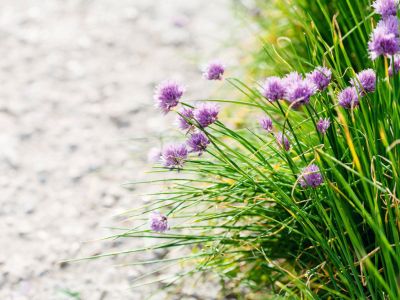About Edging with Herbs
When gardeners plan a new garden space, they usually map out the shape of the bed, prepare the soil for planting and sketch out the location of trees, shrubs, and other plants. What is often an afterthought, if a thought at all, is edging. Edging or creating borders often between the garden bed and lawn is the finishing touch. Although it is a finishing touch, it’s actually the first thing the eye is drawn to. It also plays an important role by setting boundaries while also illuminating and complementing certain features of the garden. There are quite a few herbs useful as borders or edging. Edging with herbs is a practical, low maintenance, edible solution to outlining the garden. Plus, placing herbs on the outside edge of a bed makes them readily accessible, easily in reach to snip their aromatic foliage.
Types of Herbs for Herb Edging
Many herbs are suited for edging pathways, vegetable gardens, or perennial beds. If the border is at risk for being trampled on by pets or kids, stick to herbs that can take a beating such as thyme or chamomile. Consider the height of the mature herb, the types of herbs you would find most useful, and those that offer the most fragrance and color. Low growing herbs include:
Dianthus
Lamb’s ear
Marjoram
Mint
Chives
Oregano
Rue
Santolina
Violet
Winter savory
Useful herbs as borders might include any of the aforementioned culinary herbs, tea herbs, as well as medicinal ones such as pennyroyal. Herbs chosen for their rich aroma or lovely bloom hues might include:
Basil
Calendula
Chamomile
Cilantro
Dill
Fennel
Feverfew
Hyssop
Nasturtium
Purple coneflower
Rosemary
Scented geraniums
How to Grow an Herb Border As you are deciding on what herbs as edging plants you might want to use, play around with the sizes. The general rule of thumb is to put low growing plants at the forefront and taller towards the back. While this makes sense, some rules were made to be broken. There is no reason that an exquisite tall bronze fennel can’t command a space at the edge of a curved path. It even adds some mystery to the garden, as in what is around the bend? Of course, a tidy row of lavender also has its place when using herbs as edging, especially if this rigid line is confining a riotous garden bed. Once you’ve decided on the plants you would like to use, you may need to complete the edge with a border of bricks, blocks, wood, or plastic edging. It isn’t necessary but does lend a finished look to the bed and keeps the lawn from spilling into the bed and the lawn mower from destroying the plants.
